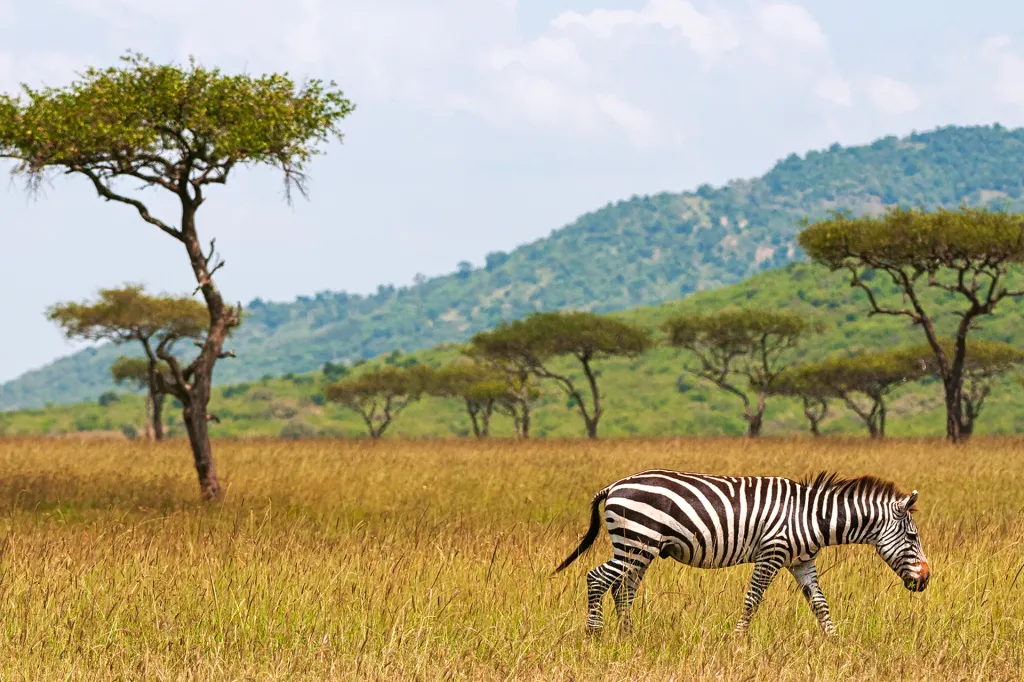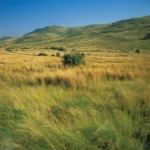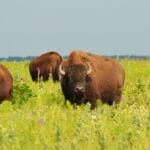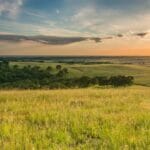Have you ever wondered why burrowing animals and ground-dwelling birds seem to love grasslands? These furry and feathered creatures are like the unsung heroes of these vast and open landscapes. They’re not just hanging out there for the view; they’re busy making a difference in the ecosystem! Let’s dig in and discover why these animals have made grasslands their home and how they play such important roles.
Why Burrowing Animals and Ground-Bound Birds Throng Grasslands
Grasslands, with their vast, open expanses, may not seem like the most welcoming habitat. However, for certain animals and birds, they’ve become a perfect paradise. Burrowing animals and ground-dwelling birds have mastered the art of thriving in these grassy plains.
The Cozy Underground Escape
Grasslands can throw some brutal weather conditions your way. Scorching heat one day, freezing cold the next, and not much shelter to hide from hungry predators. That’s where burrowing animals and ground-dwellers come in.
They’ve found an ingenious solution: burrowing underground! Their tunnels and burrows become their cozy havens, protecting them from the elements, predators, and providing a safe space to raise their little ones.
A Feast on Their Doorstep
Grasslands are like a smorgasbord for these critters. Insects, worms, and other bite-sized critters are in abundance. And since these animals live close to the ground, they’ve got easy access to their favorite snacks.
Keeping Grasslands Healthy
Burrowing animals do more than just chill in their tunnels. They play a vital role in maintaining the health of grasslands. Their burrows aerate the soil, making it more fertile for vegetation to thrive. They also help keep the population of insects and rodents in check.
Meet the Grassland Residents
The grassland is home to a variety of burrowing animals and ground-dwelling birds, each with its unique adaptations:
- Badgers: The fierce and cunning badgers dig extensive burrows, which they use for both shelter and hunting.
- Prairie dogs: These social creatures build elaborate underground towns, complete with separate rooms for living, sleeping, and feeding.
- Groundhogs: These chubby critters spend most of their time underground, venturing out only when the sun is high.
- Owls: These nocturnal hunters perch on the ground, swooping down on unsuspecting prey.
- Larks: These songbirds build their nests on the ground, amidst the tall grasses.
- Sparrows: These small birds feed on seeds and insects, often forming large flocks.
These animals and birds have all evolved to thrive in the grasslands’ unique environment, contributing to the delicate balance of this fascinating ecosystem.
Grasslands, vast and verdant, are home to a diverse array of life. From towering trees to tiny insects, these ecosystems provide essential habitats. Learn all about grasslands and their incredible biodiversity.
Wildfires, often seen as destructive forces, paradoxically play a vital role in maintaining the health of savannas and grasslands. Discover how do wildfires help maintain savannas and grasslands? and the intricate balance they create.
Beyond their beauty, grasslands are also of immense ecological importance. They are crucial for food production, water filtration, and carbon storage. Understand why are grasslands important and the vital role they play in the planet’s health.
How do burrows protect these species from the challenges of grassland environments?
Life in the grasslands isn’t easy for animals that burrow or live on the ground. It’s like being in a rollercoaster of temperatures, with no place to hide from the rain, wind, or hungry predators. But guess what? These creatures have a secret weapon: burrows!
These burrows are like secret fortresses, protecting these animals from the harsh realities of their environment.
Burrows: The Ultimate Shelter for Grassland Buddies
Burrows are like a superpower for these animals. They’re not just holes in the ground; they’re temperature-controlled havens, safe houses from the raging elements, and escape routes from hungry predators. Let’s dive into how burrows protect these species:
1. Temperature Control: Beating the Grassland Heat and Cold
Grasslands get crazy hot and cold, but burrows are like nature’s air conditioners. They stay nice and cool when it’s scorching outside, and cozy and warm when the temperature drops. It’s like having built-in heaters and ACs!
2. Weather Protection: Hiding from the Grassland Storm Troopers
Rain, wind, and all sorts of weather can turn a grassland into a battleground. But not for burrow dwellers! They’ve got their own cozy shelters to keep them dry and protected from the elements.
3. Predator Defense: Outsmarting the Grassland Hunters
Predators are always lurking in the grasslands, but burrows provide a safe hiding place. They’re like mazes, with many entrances and exits, making it super difficult for predators to catch their prey.
Examples of Burrow-Loving Species
Meet the desert tortoise, a burrow expert that digs deep holes to escape the desert heat and predators. And let’s not forget the prairie dog, the social king of the grasslands. They build elaborate underground cities, complete with chambers and escape tunnels.
Conclusion
Burrows are like secret superpowers for animals living in grasslands. They protect them from the extreme temperatures, keep them safe from rain and wind, and give them a safe haven from predators. It’s like having their own personal fortresses in the middle of a wild and unpredictable landscape.
What Ecological Roles Do Burrowing Animals Play in Keeping Grasslands Healthy?
Grasslands are vast, open spaces filled with grass. They’re home to a diverse range of animals, from tiny insects to large herbivores. One group of animals that plays a crucial role in keeping grasslands healthy is burrowing animals.
Homes for the Homeless
Just like humans need houses, animals need homes too. Burrowing animals are nature’s architects, digging tunnels and creating burrows that provide shelter for other animals. These underground hideouts protect them from predators, bad weather, and extreme temperatures. It’s like a cozy apartment complex for the grassland community!
Grass Guardians
Burrowing animals love to munch on grass. They’re like the vegetarians of the grassland. By grazing, they keep grasslands open and prevent shrubs and trees from taking over. Think of it like trimming the lawn to keep the grass short and healthy.
Food Chain Foodies
But wait, there’s more! Burrowing animals are also on the menu for other grassland predators. Predators like coyotes, foxes, and hawks see these little guys as a tasty snack. This helps control the number of predators and keeps the ecosystem balanced.
Soil Superheroes
Burrowing animals are also soil superheroes. They’re constantly digging and digging, which aerates the soil and helps water drain. It’s like giving the soil a massage! They also mix nutrients into the soil, making it more fertile for plants to grow.
Key Takeaways
- These little burrowers provide homes for other animals, like apartments in the ground.
- They keep the grass short and prevent grasslands from turning into forests.
- They’re a tasty treat for predators, who in turn keep thepredator population in check.
- They’re the gym buddies for the soil, making it strong and healthy.
So, next time you see a burrowing animal in a grassland, give them a high-five for all the hard work they do to keep this ecosystem thriving. They may be small, but their impact is enormous!
How Long Have Burrowing Behaviors Been Observed in These Species?
Burrowing has been a way of life for many animals and birds in grasslands for eons. You might wonder how these critters first started digging and why they keep doing it. Well, it all boils down to survival and comfort in the vast and ever-changing grasslands.
Evolutionary Burrowing
Burrowing isn’t just a recent thing – it’s been going on for millions of years. These animals and birds have evolved over time to burrow for various reasons:
- Shelter from danger: Predators are always on the prowl, but a cozy burrow provides a safe haven from hungry coyotes or swooping hawks.
- Temperature regulation: Grasslands can get sweltering hot or freezing cold, but burrowing critters can escape extreme temperatures by diving underground.
- Food and water access: Many insects and other small creatures make their homes in the soil. Burrowing animals have easy access to these tasty treats.
Grasslands: A Burrower’s Paradise
Grasslands are like an all-you-can-eat buffet for burrowing animals. The dense vegetation provides shelter, while the abundant insects offer a never-ending food supply. No wonder they’ve been calling this place home for millions of years!
Notable Burrowing Species
Here are some of the most notable burrowing animals and ground-dwelling birds that have thrived in grasslands:
| Species | Years of Burrowing |
|---|---|
| Prairie dog | Over 10 million |
| American badger | Around 5 million |
| Burrowing owl | Roughly 2 million |
| Vole | Over 5 million |
| Ground squirrel | 3 million years or more |
So, there you have it – burrowing behaviors have been observed in various species for millions of years, and they’re still going strong today. These behaviors offer numerous advantages that have helped these animals and birds survive and thrive in the dynamic grasslands ecosystem.
FAQ
Q1: Why are burrowing animals and ground-dwelling birds so common in grasslands?
A1: Burrowing animals and ground-dwelling birds are common in grasslands due to their adaptations to the harsh conditions. Grasslands are often characterized by extreme temperatures, frequent fires, and little cover from predators. Burrowing animals, such as prairie dogs and badgers, find refuge from these elements in underground burrows. Ground-dwelling birds, such as meadowlarks and sparrows, nest on the ground and rely on vegetation for cover.
Q2: What are the benefits of burrowing for these animals?
A2: Burrows provide burrowing animals with shelter from predators, extreme temperatures, and frequent fires. They also provide a place to raise young and store food. Some burrowing animals, such as pocket gophers, even dig to find their food, which is often insects, worms, or plant roots.
Q3: How do burrowing animals and ground-dwelling birds contribute to the health of grassland ecosystems?
A3: Burrowing animals play an important role in maintaining grassland health by preventing the invasion and establishment of shrubs. They do this through their foraging and clipping of vegetation. Ground-dwelling birds help to control insect populations and disperse seeds.
Q4: What are the threats to burrowing animals and ground-dwelling birds?
A4: The biggest threats to burrowing animals and ground-dwelling birds are habitat loss and fragmentation. Other threats include hunting, trapping, and poisoning.
Q5: What can be done to protect burrowing animals and ground-dwelling birds?
A5: To protect burrowing animals and ground-dwelling birds, we need to protect their habitats. This can be done by creating wildlife refuges, setting aside land for conservation, and implementing sustainable land management practices. We can also help these animals by reducing our use of pesticides and herbicides, and by driving carefully in areas where they are known to be present.
- How many feet is 300 meters? 984 Feet: Understand Length Conversions Easily - March 31, 2025
- Senior at What Age: Benefits & Eligibility Guide - March 29, 2025
- Unlocking Senior Benefits: How Old is a Senior? Your Complete Guide - March 29, 2025
















